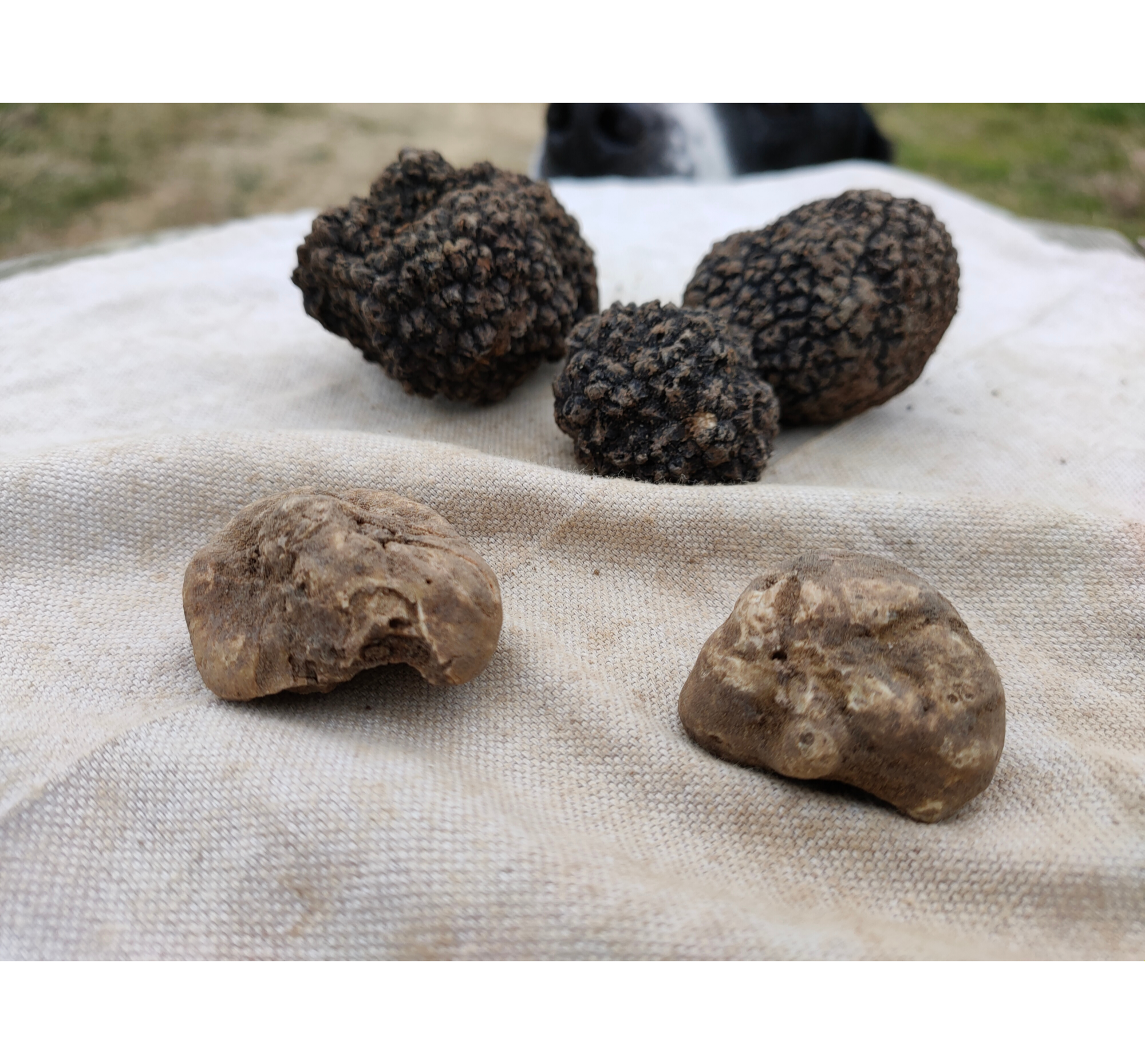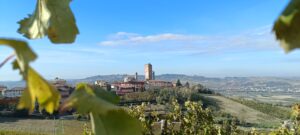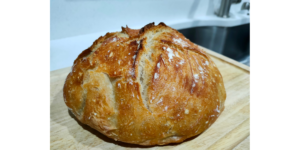
As a former restaurant owner and hospitality consultant, my work has taken me all over the world. I split my time between the U.S. and Italy, but I truly consider Barolo, Piemonte home as it’s also where I live for most of the year. The highest quality truffles can be found in this stunning food and wine mecca.
In the first part of this series, I covered truffle basics and the science behind their creation. Today in part 2 (What Is A Truffle? How To Select Truffles), we’ll explore the different types found in Piemonte and throughout Italy. I’ll also give you the info you’ll need to determine the best quality.
How do you know if the truffle you are buying is a good one?
Here is a guide that you can reference the next time you are thinking about buying truffles:
SIGHT
The first thing to do when assessing the quality of a white truffle is to use your eyes. Only three senses are used for adjudicating truffle quality and sight is an important one.
Color Intensity: An evaluation of the color, ranging from milky white, pale yellow to very light brown. The color indicates the quality and type of soil you will find the truffle in; this can affect its sense of smell later.
Globosity: A way to measure how close a truffle is to a perfect circle. The closer the truffle is to a circle, the higher quality and price it will be given. The type of soil it grows in will have a huge effect on the shape of the truffle. If the soil it comes from is clay or is filled with lots of stones, the truffle will lose its circular shape as those soils are more compact, making it difficult for the truffle to grow.
Size: Naturally, a larger truffle is given a higher value which means it is worth more. The only reason for this is that there is a limited amount of truffles retrieved from the ground each year and large truffles by default are more rare for their cult-like status.

Cleanliness: If a truffle has more soil clinging to its exterior, it is worth less. A high quality truffle should not have any dirt or soil clinging to the outside as it can hide imperfections and prevent the appreciation of other features.
Wholeness: A truffle that is without scratches or defects from the truffle hunter or his dog. This indicates a healthy truffle extracted by a truffle expert and a well-trained dog. Insects that have eaten at the fungus (thereby destroying its wholeness or introducing unwanted decay or bacteria) can also disrupt the integrity of the truffle.
Surface Regularity: How regular are the peaks and natural crowns found on the outside of the truffle? Does it have a consistent pattern? A more consistent surface assigns a higher value to the truffle.
Appeal: The visual appeal of the truffle as a whole. It should cumulatively score high on all of the other characteristics mentioned here.
TOUCH
The sense of touch is a very difficult thing to use when assessing truffle quality. To properly adjudicate truffles much care must be taken when handling them. Gloves should be used to prevent the deposit of oils or bacteria found in your hands as it can alter the sense of smell and integrity of the truffle. We only examine for two categories (texture/pleasantness) when touching a truffle.
Texture/Pleasantness: Grasp the truffle between your thumb and forefinger and gently press the truffle. A truffle that feels a bit more dense and springs back into its original form is considered the highest quality. As a truffle becomes more ripe, it becomes “ mushier”, therefore it’s not as fresh and reaching the end of its edibility. Or it could indicate that it was improperly preserved and harvested too long ago. When pressed, a truffle that appears to be too hard can indicate that it was harvested too early, making it unripe and without the strong, alluring sense of smell.
SMELL
Our sense of smell is the strongest of all of our senses. It’s tied into over 8 million neurons in our olfactory glands, making it easily the most complicated of our senses as well. The following is a list of descriptors we use when assessing a truffle’s sense of smell.
Intensity: This is an indication on how much volume of scent we have in a particular truffle. This can also measure how ripe a truffle is and/or how fresh it might be. A very intense smelling truffle does not indicate quality unless it’s of the high quality characteristics.
Mushroom: How intense is the smell of mushroom found in the truffle? Which type of mushroom does the truffle smell like? Porcini or Champignons? Different mushrooms have different smells and prices. For example, Porcini mushrooms smell great and cost a great deal more than others.
Honey: Do you smell a certain sense of wild flower honey in the truffle? If you answered yes, this would indicate a complex, fresh and harmonious white truffle.
Hay: It is important to note that hay itself has many different levels of scent. When smelling a truffle you should be looking for the clean-smelling, high quality type of hay you would find in the loft of a barn. If it has the smell of green grass or fermented wet hay than this would be a low quality truffle. If you grew up on or near a farm this is an easy one to understand.
Garlic: A high quality truffle will show a certain level of garlic which also indicates that the truffle is the perfect ripeness as this smell only comes about as it ripens.
Spices: An extremely well rounded white truffle will have the scent of a freshly opened jar of spices – cinnamon, nutmeg, clove and other baking spices. When a white truffle is the perfect density (fresh and ripe) it will possess one or more of these characteristics.
Wet Soil: Does the truffle have a certain wet soil smell that is of high quality? Typically, a high quality truffle might have the sense of undergrowth found in a forest as well.
Ammonia: The presence of ammonia in a truffle or mushroom means that it is beyond maturity and beginning to decay. This would be a low quality truffle.

There is quite a bit of thought and deduction that goes into assessing the quality of a truffle. I should also note that there are many species of truffles found in Italy and the rest of the world, but one is above all the others…the white truffle of Alba. In blind panels featuring judges and regular consumers from all over the world, the white truffle of Alba is chosen as the best 95% of the time. This doesn’t mean that others aren’t good, but they just aren’t as rare and as hedonistic as some might say.
Some of the other truffles you will find in Italy and the rest of the world with their respective seasons are as follows:
- Precious White: Late summer, autumn and early winter
- Precious Black: winter
- Marzuolo: Late winter and early spring
- Scorzone: Harvested all year round with a short break in spring coming out of winter
- Smooth Black: Late summer, autumn and early winter
- Ordinary Truffle: Autumn and winter
- Winter Black: Only in winter; can withstand the lowest temperatures
Italians are passionate about their truffles and it clearly shows when you travel to the country. You can book an amazing trip to Barolo to experience a truffle hunt and see firsthand why white truffles are so special. Italy has over 80,000 registered truffle hunters constantly searching the woods to find these delicacies. It is important to know the best hunters who know exactly what they are doing when carefully extracting truffles from the earth. I would love to introduce you to some of my truffle-hunting friends who can show you why they are so amazing.
For the final part of this series, we’ll explore the Food & Wine of Piemonte and the types of dishes and wines that pair well with truffles.



